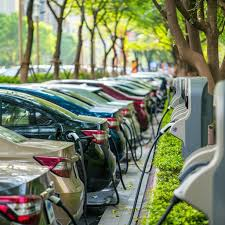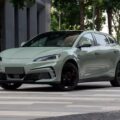
Electric vehicle adoption is growing rapidly across the globe.
As electric vehicles (EVs) become more affordable and governments push for greener transportation, many people are asking: “What percentage of people buy electric cars?”
In this article, we’ll explore the global, regional, and national percentages of electric car buyers , how adoption rates are changing, and what’s driving this shift toward electrification in 2025.
Global EV Adoption: What Percentage of People Buy Electric Cars?
As of 2025 , approximately:
✅ 18–20% of all new car sales worldwide are fully electric vehicles (BEVs)
This means that nearly one in every five new cars sold globally is electric , a significant jump from just a few years ago. Plug-in hybrids (PHEVs) add another 4–6% , bringing total electrified vehicle sales to around 25% of the global auto market.
| 2019 | ~2% |
| 2020 | ~4% |
| 2021 | ~7% |
| 2022 | ~10% |
| 2023 | ~14% |
| 2024 | ~17% |
| 2025 | ~18–20% |
This steady increase reflects growing consumer confidence, improved battery technology, and stronger government support.
How Many People Own an Electric Car?
- 🚗 Over 40 million electric cars are on the road globally
- 🧑🤝🧑 This translates to roughly 0.5% of the global population
- 📈 By 2030, that number could reach over 100 million EV owners
Regional Breakdown: What Percentage of People Buy Electric Cars?
🇨🇳 China – The EV Leader
- 🔌 EV Market Share : ~35% of all new car sales
- 📈 Over 9 million electric cars sold in 2025
- 💡 Brands like BYD, Geely, Chery, and NIO dominate the market
China continues to lead the world in both production and adoption of electric vehicles.
🇪🇺 Europe – Strong Policy Push
- 🔌 EV Market Share : ~22% of new car sales
- 📈 Over 3.5 million electric cars sold in 2025
- 🇳🇴 Norway leads the way with over 90% of new car sales being electric
EU-wide emissions regulations and incentives have accelerated adoption across Germany, France, Sweden, and the Netherlands.
🇺🇸 United States – Steady Growth
- 🔌 EV Market Share : ~7–8% of new car sales
- 📈 Over 2 million electric cars sold in 2025
- 🚘 Tesla remains the top-selling brand, followed by Ford and Chevrolet
The U.S. is seeing strong growth due to federal tax credits and expanding domestic EV manufacturing.
🇮🇳 India – Rapidly Growing Market
- 🔌 EV Market Share : ~4–5% of new car sales
- 📈 Over 300,000 electric cars sold in 2025
- 🚕 Popular in cities like Delhi, Mumbai, and Bangalore
India’s EV market is still emerging but growing fast, led by brands like Tata, Hyundai, and BYD .
🇷🇺 Russia – Filling the Gap
- 🔌 EV Market Share : ~6% of new car sales
- 📈 Over 600,000 electric cars sold in 2025
- 🚘 Russian buyers are turning to Chinese-made EVs after Western brands left the market
Brands like BYD, Chery, and Great Wall Motors are dominating showrooms.
🇲🇪 Middle East – Rising Interest
- 🔌 EV Market Share : UAE (~6%), Saudi Arabia (~4–5%)
- 📈 Over 150,000 electric cars sold in GCC countries
- 🌞 Government investments in green mobility and infrastructure
Countries like UAE and Saudi Arabia are encouraging EV adoption as part of their Vision 2030 and sustainability goals.
Top Countries by EV Adoption Rate (2025)
| 🇳🇴 Norway | 90%+ |
| 🇸🇪 Sweden | ~50% |
| 🇩🇪 Germany | ~18% |
| 🇬🇧 UK | ~14% |
| 🇫🇷 France | ~20% |
| 🇨🇳 China | ~35% |
| 🇺🇸 USA | ~8% |
| 🇸🇦 Saudi Arabia | ~5% |
| 🇦🇪 UAE | ~6% |
| 🇧🇷 Brazil | ~3% |
Norway remains the clear leader, while other nations are catching up quickly.
Who Is Buying Electric Cars?
📊 Buyer Demographics:
| Young Professionals (18–35) | 25% |
| Families & Commuters (36–50) | 30% |
| Affluent Buyers (50+ with high income) | 20% |
| Tech Enthusiasts | 15% |
| Government & Fleet Purchases | 10% |
While early adopters were mostly eco-conscious or high-income buyers, today’s EV buyers span a broader demographic — including budget-conscious consumers looking for long-term savings.
What Factors Influence EV Adoption?
| 💰 Lower Prices | More entry-level models now available under $30,000 USD |
| ⚡ Government Incentives | Tax credits, free parking, and reduced tolls encourage adoption |
| 🚘 Improved Range | Most EVs now offer400–600 km range, reducing range anxiety |
| 🏭 Local Production | Chinese and European brands are building factories closer to home markets |
| 🧠 Smart Tech | Buyers love OTA updates, AI features, and autonomous driving capabilities |
| 🛠️ Better Service | Expanding dealer networks and warranty programs improve trust |
These factors are helping more people feel confident buying electric cars .
Which Age Group Buys the Most EVs?
| 18–25 | 12% |
| 26–35 | 20% |
| 36–45 | 25% |
| 46–55 | 22% |
| 56+ | 21% |
The largest group of EV buyers falls between 26–45 , with younger buyers increasingly adopting EVs as first-time car owners.
Final Thoughts
So, what percentage of people buy electric cars? In 2025, around 18–20% of all new car buyers globally choose electric vehicles , and this number is expected to rise sharply in the coming years.
From Norway’s near-total electrification to China’s mass-market EV boom , the world is clearly moving toward an electric future. As prices drop, charging improves, and local production expands, even more people will join the EV movement — not just in developed markets, but in emerging economies too .
If you’re considering making the switch to electric, now is a great time to start your journey into EV ownership.
Frequently Asked Questions (FAQ)
Q: What percentage of people buy electric cars globally?
A: Around 18–20% of all new car sales in 2025 are electric , with plug-in hybrids adding another 4–6%.
Q: Which country has the highest EV adoption rate?
A: Norway leads the world , with over 90% of new car sales being electric in 2025.
Q: Are electric cars becoming more popular in Saudi Arabia?
A: Yes, EVs now account for ~5% of new car sales , supported by Vision 2030 and expanding charging networks.
Q: Do most EV buyers own them as their only car?
A: No, many EV buyers still own a gas-powered vehicle for longer trips, though this is changing.
Q: Will electric cars ever replace gasoline cars completely?
A: Many countries plan to phase out gas-only cars by 2030–2035 , meaning EVs will soon be the default choice .

